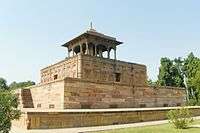Shah Begum (wife of Jahangir)
Shah Begum (Persian: شاہ بیگم; c. 1570 - 16 May 1604), meaning 'the royal lady', was a rajput and the first wife of Prince Salim future Emperor Jahangir.
| Shah Begum | |
|---|---|
| Shah Begum | |
 Tomb of Shah Begum | |
| Born | Rajkuwri Man Baisa Sahiba c. 1570 Amer kingdom |
| Died | 16 May 1604 (aged 33–34) Allahabad, Mughal Empire |
| Burial | |
| Spouse | Jahangir |
| Issue | Sultan-un-Nissa Begum Khusrau Mirza |
| House | Kachhwaha (by birth) Timurid (by marriage) |
| Father | Raja Bhagwant Das |
| Religion | Hinduism |
Family
Born as Man Bai,[1] she was the daughter of Raja Bhagwant Das, the ruler of Amer.[2] She was the granddaughter of Raja Bharmal, whose daughter Jodha Bai had been married to Akbar the Great in 1562, and by him was the mother of Jahangir.[3] She became the mother of Salim's eldest son Khusrau Mirza after which she was given the title of Shah Begum by Salim.
Marriage
At the age of fifteen, Salim was betrothed to his cousin, Man Bai. The marriage settlement was fixed at two crores of tankas. Akbar himself, accompanied by all his nobles, went to the Raja's mansion and on 13 February 1585, celebrated the wedding in the presence of Muslim qazis, but with certain characteristic Hindu ceremonies.[4]
The dowry bestowed by Bhagwant Das included a hundred elephants, several strings of horses, jewels, numerous and diverse golden vessels set with precious stones, utensils of gold and silver, and all sorts of riches, the quantity of which is beyond all computation. The imperial nobles were presented with Persian, Turkish, and Arabian horses, with golden saddles. Along with the bride were given a number of male and female slaves, of Indian, Abyssinian and Circassian origin.[5] As the Imperial procession returned along highways covered with rare and choice cloth, the Emperor scattered over the bridal litter gold and jewels in careless profusion.[6]
The couple's first child was a daughter named Sultan-un-Nissa Begum, who was born on 25 April 1586 and died on 5 September 1646.[7] She lived for sixty years but played no part in history. The couple's second child was a son named Khusrau Mirza, who was born on 6 August 1587. On his birth, Man Bai was given the title of "Shah Begum" meaning "The royal lady".[8][9]
She was described to be a very beautiful woman. With her fidelity and sincere devotion to Jahangir, she won a special place in his heart. She was a neurotic woman, quick to take offence over imagined insults, for which there was plenty of scope for the Rajput princess in Jahangir's polygamous and predominantly Muslim household. "The lady [Shah Begum] was ever ambitious of an ascendancy over the other inmates of the harem, and grew violent at the slightest opposition of her will" said Inayatullah. "From time to time her mind wandered, and her father and brothers all agreed in telling me she was insane," writes Jahangir.[10]
Shah Begum constantly advised Khusrau to be loyal to his father. When she saw that it was of no use, she decided to take her own life which was an integral part of Rajput nature.[11]
Death
Shah Begum died on 16 May 1604.[12] With her mind of in a state of imbalance she ate a lot of opium and died thereafter. She was incapable of tolerating the misconduct of her son and brother toward Jahangir, and despaired her life in a circumstantial trauma.[13]
Shah Begum's tomb is located in Khusrau Bagh, Allahabad. Aqa Reza, the principal artist at Allahabad court was charged with the responsibility for constructing her tomb. It was completed in 1606-7.[14]
In popular culture
Neetha Shetty portrayed Shah Begum in EPIC channel's critically acclaimed historical drama Siyaasat (based on the Twentieth Wife).
See also
References
- Prasad, Ishwari (1974). The Mughal Empire. Chugh Publications. p. 294.
- The Proceedings of the Indian History Congress - Volume 64. Indian History Congress. 2004. p. 598.
- Flores, Jorge (20 November 2015). The Mughal Padshah: A Jesuit Treatise on Emperor Jahangir's Court and Household. BRILL. pp. 91 n. 23. ISBN 978-9-004-30753-7.
- Prasad 1930, p. 29.
- Ojha, P. N (1975). North Indian social life during Mughal period. Oriental Publishers & Distributors. p. 131.
- Prasad 1930, p. 29-30.
- Jahangir, Emperor; Thackston, Wheeler McIntosh (1999). The Jahangirnama : memoirs of Jahangir, Emperor of India. Freer Gallery of Art and the Arthur M. Sackler Gallery, Smithsonian Institution; New York: Oxford University Press. pp. 7 n. 20, 29 n. 36.
- Sharma, S. R. (1999). Mughal Empire In India: A Systematic Study Including Source Material, Volume 2. Atlantic Publishers & Dist. p. 310. ISBN 978-8-171-56818-5.
- Nicoll, Fergus (2009). Shah Jahan: The Rise and Fall of the Mughal Emperor. Penguin Books India. p. 26. ISBN 978-0-670-08303-9.
- Eraly, Abraham (2000). Emperors of the Peacock Throne : the saga of the great Mughals. Penguin books. pp. 273. ISBN 9780141001432.
- Jahangir, Emperor; Thackston, Wheeler McIntosh (1999). The Jahangirnama : memoirs of Jahangir, Emperor of India. Freer Gallery of Art and the Arthur M. Sackler Gallery, Smithsonian Institution; New York: Oxford University Press. pp. 51.
- Journal of the Royal Asiatic Society of the Great Britain and Ireland. Cambridge University Press for the Royal Asiatic Society. 1907. p. 604.
- Jahangir, Emperor; Rogers, Alexander; Beveridge, Henry (1909). The Tuzuk-i-Jahangiri; or, Memoirs of Jahangir. Translated by Alexander Rogers. Edited by Henry Beveridge. London Royal Asiatic Society. pp. 56.
- Asher, Catherine B. (24 September 1992). Architecture of Mughal India, Part 1, Volume 4. Cambridge University Press. p. 104. ISBN 978-0-521-26728-1.
Sources
- Prasad, Beni (1930). History of Jahangir. The Indian Press, LTD, Allahbad.
External links
- "History of Islam in India The World Conqueror: Jahangir (1569-1627) by Dr. Neria H. Hebbar". Boloji.com. 12 June 2002. Retrieved 18 May 2017.